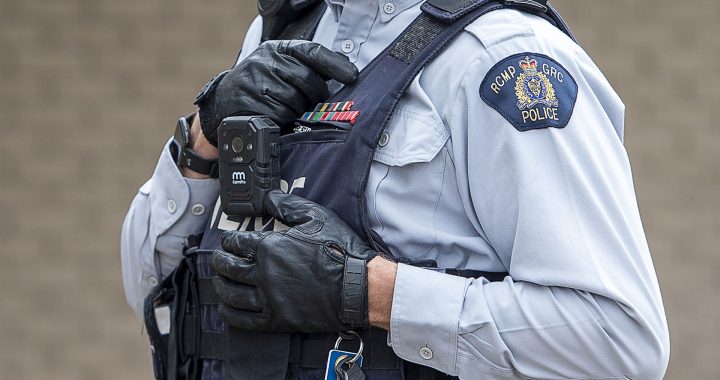
The RCMP emblem on the side of a police cruiser. Photo: APTN News file
A special report from Statistics Canada says that when non-essential businesses were closed from March to April, almost all types of crime decreased except for wellness checks, mental health checks and domestic disturbances.
According to the report, crime increased once businesses and services began to re-open.
Data from 17 police services was done over the course of the first six months of the COVID-19 pandemic for the Statistics Canada report that was released Monday.
“Most notably, police services that were able to report data on calls for service responded to more calls related to general wellbeing (welfare) checks (+12%), domestic disturbances (+12%) and mental health-related such as a person in an emotional crisis (+11%),” said the report.
“Of the three police services that were able to provide data on calls to check on the welfare of a child separately from calls for domestic disturbances, all three reported increases in this type of call (+19%, overall). Calls to police classified as domestic disturbances or domestic disputes can involve anything from a verbal quarrel to reports of violence at a residence.”
The police services involved with the report serve 59 per cent of Canada’s population, and include the RCMP, Winnipeg Police Service and Ontario Provincial Police.
The report shows that from March to August 2020 there were 16 per cent fewer criminal incidents for select offences during the first six months of the pandemic compared with the same period one year earlier.
However, the number of calls for services like wellness checks, mental health checks and calls to attend domestic disturbances rose 8 per cent during the same time.
Chantel Moore and Rodney Levi were both shot and killed by police officers in New Brunswick in June 2020. Moore was killed after Edmundston officers responded to a wellness check on the 26 year-old. Levi was shot and killed after RCMP officers responded to a home in Sunny Corner.
Subhead: Indigenous Peoples six times more likely to be victim of homicide
This follows another Statistics Canada report issued on crime in early October that says First Nation, Metis and Inuit Peoples are more likely to be the victim of a homicide than non-Indigenous people in the country.
According to records obtained by Stats Can from police reports, there were 174 Indigenous homicide victims in 2019, 33 more than in 2018.
“Almost two-thirds of the victims identified as Indigenous were First Nation (63 per cent), while 3 per cent were Métis and 11 per cent were Inuk (Inuit). The Indigenous group was not identified for 22 per cent of all Indigenous homicide victims.”
The report said, there were “five few female homicide victims in 2019, while there were 40 in 2018…. And 20 more male Indigenous homicide victims (from 96 to 116).”
The latest statistics come from a wide-ranging report on crime across Canada.
The report said the “homicide rate for Indigenous peoples (First Nation, Métis and Inuit) was six and a half times higher (8.82 homicides per 100,000 population) than for Canada’s non-Indigenous population (1.34 per 100,000 population).
“Indigenous peoples accounted for 5 per cent of Canada’s population, but 27 per cent of all homicide victims nationally in 2019. Since 2014, when reporting of this information began, Indigenous victims have accounted for approximately one-quarter of all homicide victims each year.”
Stats Can said the homicide rate for Indigenous males was more than twice that of Indigenous women. The report said there were 11.89 homicides per 100,000 people population – nearly three times that for Indigenous females which sits at 4.01 per 100,000 population. That makes the rate “six times higher than for non-Indigenous males. Non-Indigenous females (0.55 per 100,000 population) had the lowest homicide rate in 2019.”
According to the report, police-reported crime in Canada increased 5 per cent in the year prior to the pandemic – the fifth yearly increase according to Stats Can.
Homicide rates increased in Manitoba, Saskatchewan and Alberta.
Saskatchewan home to two of Canada’s most violent cities
Saskatchewan might be one of the flattest provinces in the country when it comes to landscape, but the same cannot be said for some of the crime rates.
According to the report, two of the three most violent cities in the country are in the province of Saskatchewan, based on of the crime severity index (CSI). The CSI index measures changes in the level of severity of crime in Canada from year to year.
North Battleford is the most violent and Prince Albert the third most violent. Thompson, Man., comes in at number two.
The rise in violence and crime has been happening for over a decade says Prince Albert chief of police Jon Bergen.
“Looking at our ranking since 2009 we can see that Prince Albert has consistently been in the top five for violent crime almost every year often in the top two or three,” he said.
Bergen added he believes the COVID-19 pandemic is a major factor in the latest report’s high numbers. A Prince Albert Police press release shows that while violent crime may trending up, overall crime has actually decreased the last two years.
“We know the challenges of the pandemic and COVID-19 and the financial stresses and all these factors are really going to challenge our mental health and wellness and is that one of the factors in the violent crime that we’ve seen and you think it is,”he said.
Watch Priscilla Wolf’s story here:
While the pandemic may be a major reason as to why the violence are increasing, social problems and gangs are at the root of why violence and crime are so high in the cities.
“We can have hundred cops on the street and if we don’t start looking at the causes of all the crime the homeless the gangs the drugs the alcohol and how did they get there if we don’t start dealing with that it’s not going to go away,” said Sheryl Kimbley, chair of the Prince Albert Police Commission.
“Crime doesn’t stop because we put more men in the street or because we cut the budget and we put money elsewhere.”
The Prince Albert police are not naming any gangs specifically but Bergen says the crime and conflicts among gangs is evident in the 2019 statistics.
“When we look at these results for 2019 there was some gang activity that was a factor in violent crime rates what we are looking at currently in recent violence absolutely it’s been related to gang activity and conflict within a group.”
Kimbley said that the violence is also taking a human and social toll on those involved in trying to prevent crime and violence.
“I know people often look at these statistics and they forget about the people the people that are actually moving the stuff and the people who have to take time out of their life’s and families to protect us and it’s something they do daily,” she said.”
The report is based off of rates from 2018-2019 and do not reflect the current year.









